1993 CHEVROLET S10 heater
[x] Cancel search: heaterPage 208 of 356
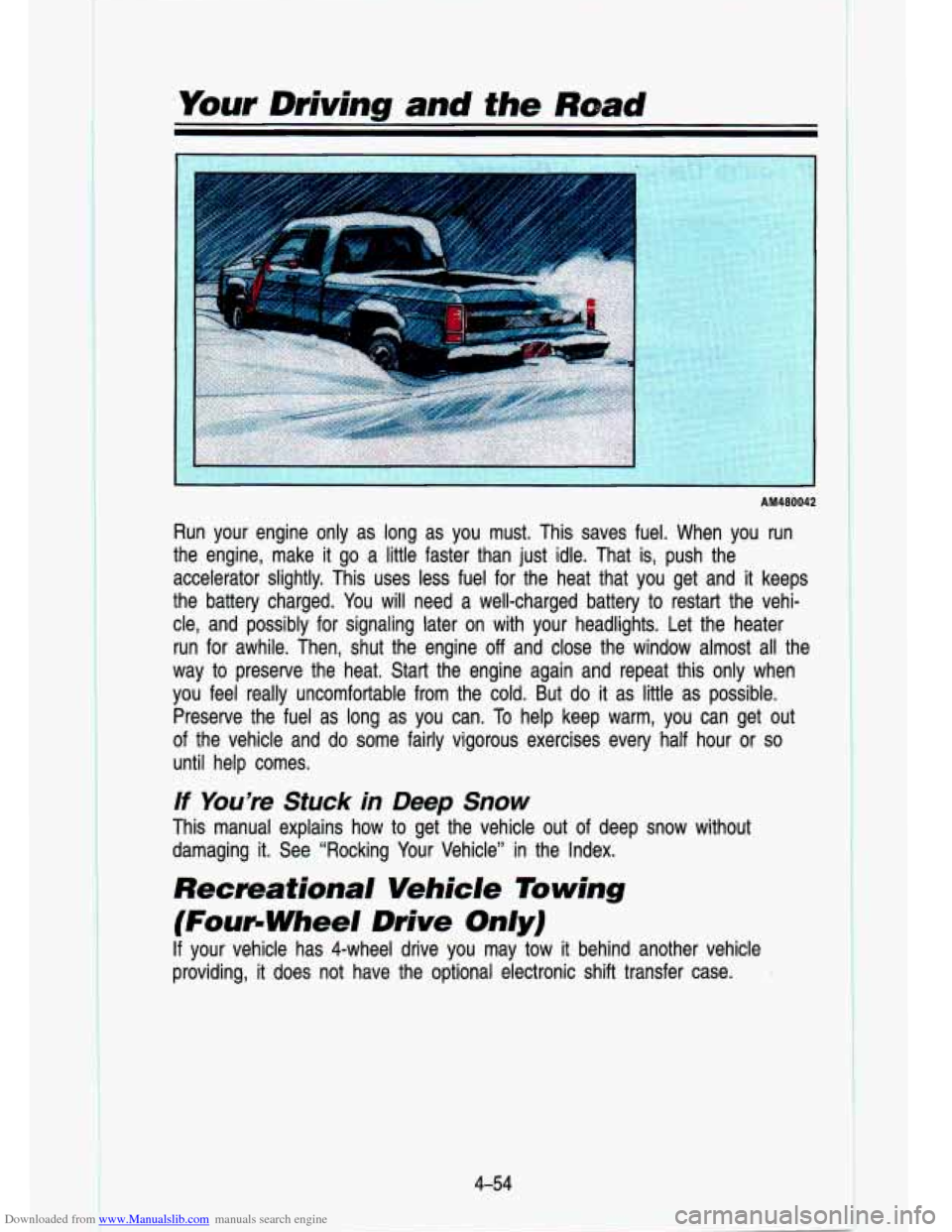
Downloaded from www.Manualslib.com manuals search engine -.
-.
”, . c.
Your Driving and the Road
-
. ..
..
I>: ”
.,. .,,-.
‘6
AM480042
Run your engine only as long as you must. This saves fuel. W\
hen you run
the engine, make it go a little faster than just idle. That is, push the\
accelerator slightly. This uses less fuel for the heat that yo\
u get and it keeps
the battery charged. You will need
a well-charged battery to restart the vehi-
cle, and possibly for signaling later on with your headlights. Let the heater
run for awhile. Then, shut the engine
off and close the window almost all the
way
to preserve the heat. Start the engine again and repeat this only\
when
you feel really uncomfortable from the cold. But
do it as little as possible.
Preserve the fuel as long as you can.
To help keep warm, you can get out
of the vehicle and
do some fairly vigorous exercises every half hour or so
until help comes.
lf You’re Stuck in Deep Snow
This manual explains how to get the vehicle out of deep snow without
damaging it. See “Rocking Your Vehicle’’ in the Index.
Recreational Vehicle Towing
(Foue Wheel Drive Only)
If your vehicle has 4-wheel drive you may tow it behind another vehicle
providing, it does not have the optional electronic shift trans\
fer case.
4-54
Page 226 of 356

Downloaded from www.Manualslib.com manuals search engine Problems on the Road
If No Steam Is Coming From Your Engine:
If you get the overheat warning but see or hear no steam, the problem may
not be too serious. Sometimes the engine can get a little
too hot when you:
Climb a long hill on a hot day.
Stop after high speed driving.
Idle for long periods in traffic.
Tow a trailer.
If you get the overheat warning with no sign of steam, try this for a minute
or so:
1. If you have an air conditioner, turn it off.
2. Turn your heater to full hot at the highest fan speed and open the
3. If you're in a traffic jam, shift to N (Neutral).
window as necessary.
If you no longer have the overheat warning, you can drive. Just to
be safe,
drive slower for about ten minutes. If the warning doesn't com\
e back on, you
can drive normally.
If the warning continues, pull over, stop, and park your vehicle \
right away.
If there's still no sign of steam, push the accelerator until the engine speed is
about twice as fast as normal idle speed. Bring the engine sp\
eed back to
normal idle speed after
two or three minutes. Now see if the warning stops.
But then,
if you still have the warning, TURN OFF THE ENGINE AND GET
EVERYONE
OUT OF THE VEHICLE until it cools down.
You may decide
not to lift the hood but to get service help right away.
KO71 5
5-1 0
I
Page 227 of 356
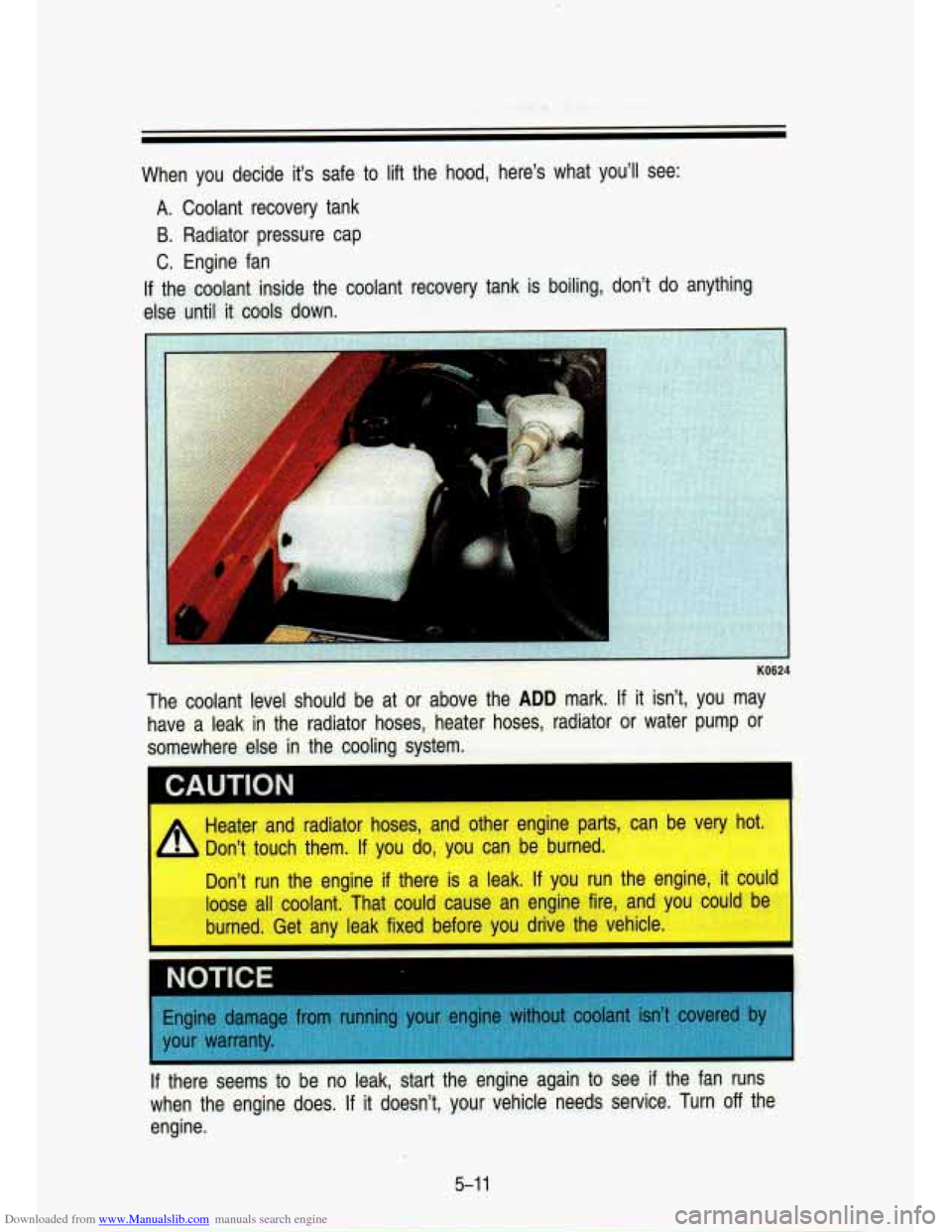
Downloaded from www.Manualslib.com manuals search engine When you decide it's safe to lift the hood, here's what you'll see:
A. Coolant recovery tank
B. Radiator pressure cap
C. Engine fan
If the coolant inside the coolant recovery tank is boiling, don't do anything
else until it cools down.
The coolant level should be at or above the
ADD mark. If it isn't, you may
have a leak in the radiator hoses, heater hoses, radiator or water pump or
somewhere else in the cooling system.
CAUTION I
Heater and radiator hoses, and other engine parts, can be very\
hot.
Don't touch them.
If you do, you can be burned.
loose all coolant. That could cause an engine fire, and you could be
burned. Get any leak fixed before you drive the vehicle. run the engine
if there is a leak. If you run the engine, it could
NOTICF
If there seems
to be no leak, start the engine again to see if the fan runs
when the engine does.
If it doesn't, your vehicle needs service. Turn off the
engine.
5-1 1
Page 261 of 356
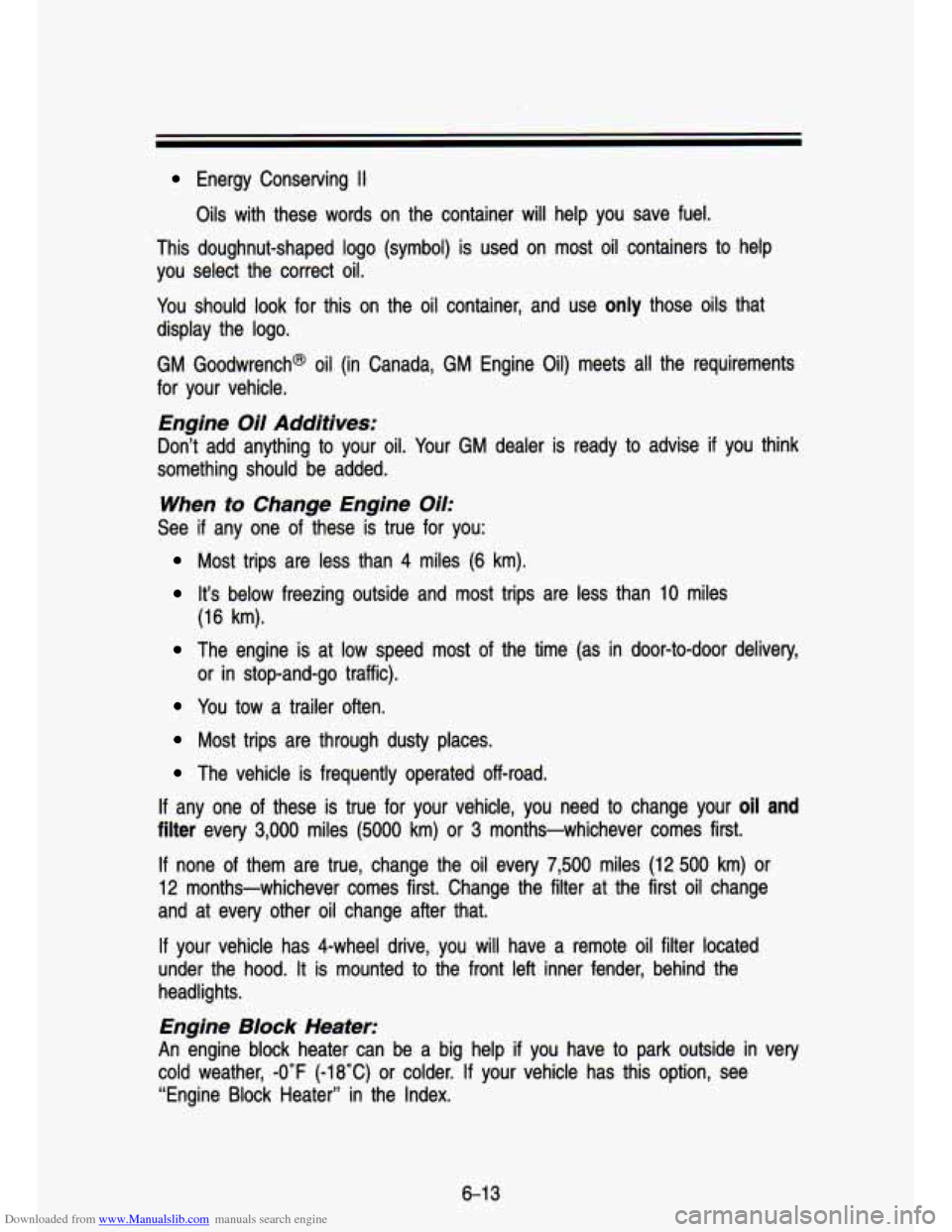
Downloaded from www.Manualslib.com manuals search engine Energy Conserving II
Oils with these words on the container will help you save fuel.
This doughnut-shaped logo (symbol) is used
on most oil containers to help
you select the correct oil.
You should look for this on the oil container, and use
only those oils that
display the logo.
GM Goodwrench@ oil (in Canada, GM Engine Oil) meets all the requirements
for your vehicle.
Engine Oil Additives:
Don’t add anything to your oil. Your GM dealer is ready to advise if you think
something should be added.
When to Change Engine c)k
See if any one of these is true for you:
Most trips are less than 4 miles (6 km).
It’s below freezing outside and most trips are less than 10 miles
(16 km).
The engine is at low speed most of the time (as in door-to-door delivery,
You tow a trailer often.
or in stop-and-go traffic).
Most trips are through dusty places.
The vehicle is frequently operated off-road.
If any one of these is true for your vehicle, you need to chang\
e your oil and
filter every 3,000 miles (5000 km) or 3 months-whichever comes first.
If none of them are true, change the oil every 7,500 miles (12 500 km) or
12 months-whichever comes first. Change the filter at the first oil change
and at every other oil change after that.
If your vehicle has 4-wheel drive, you ,will have a remote oil filter located
under the hood.
It is mounted to the front left inner fender, behind the
headlights.
Engine Block Heater:
An engine block heater can be a big help if you have to park outside in very
cold weather,
-0°F (-18°C) or colder. If your vehicle has this option, see
“Engine Block Heater” in the Index.
6-1 3
Page 310 of 356
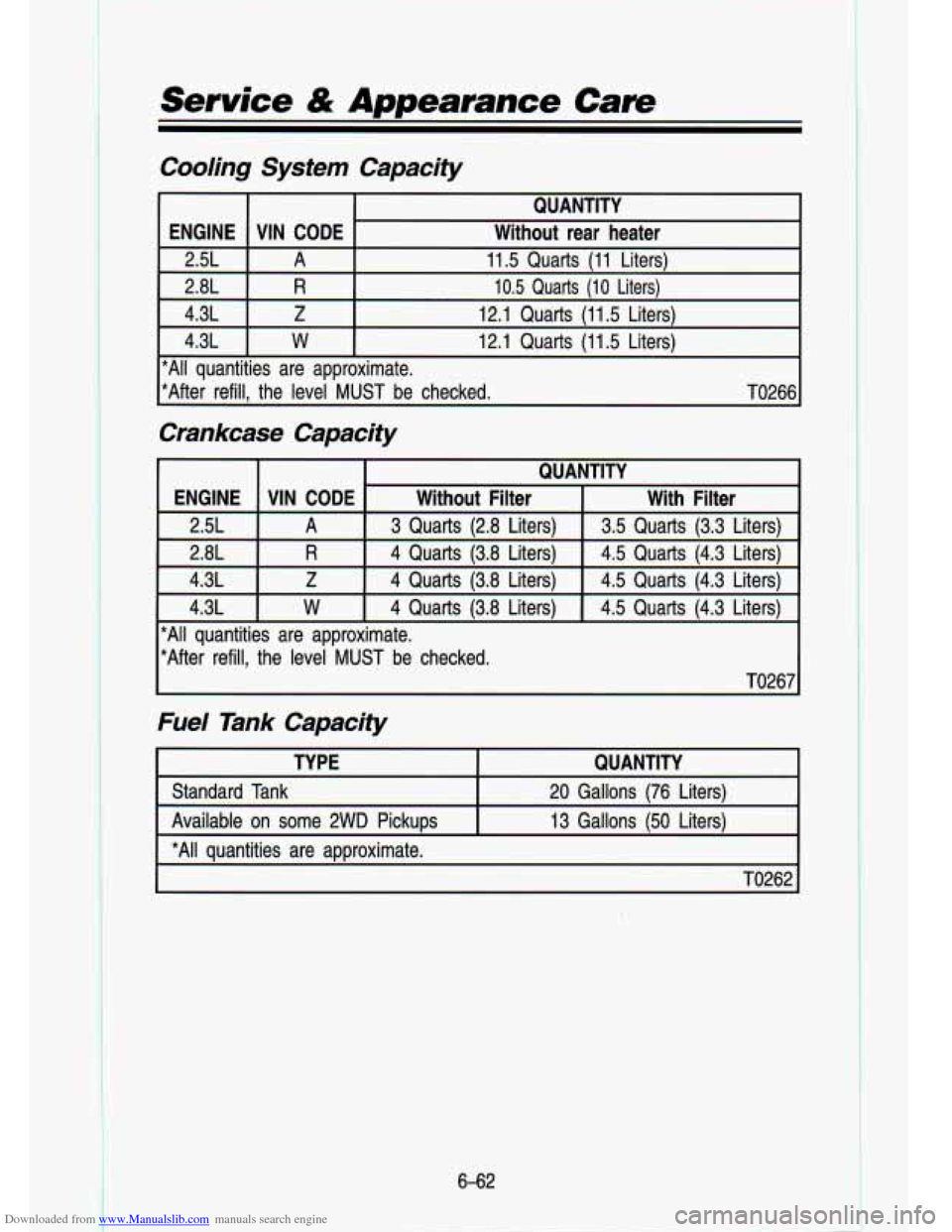
Downloaded from www.Manualslib.com manuals search engine Service & Appearance Care
Cooling Sysfem Capacity
QUANTITY
ENGINE VIN CODE Without rear heater 2.5L
A 11.5 Quarts (11 Liters)
2.8L
R 10.5 Quarts (10 Liters)
4.3L
Z 12.1 Quarts (11.5 Liters)
4.3L W
12.1 Quarts (11.5 Liters)
*All quantities are approximate.
*After refill, the level
MUST be checked. TO266
Crankcase Capacity
ENGINE I VIN CODE I Without Filter I With Filter I
2.5L I A I 3 Quarts (2.8 Liters) I 3.5 Quarts (3.3 Liters) I
2.8L R 4 Quarts (3.8 Liters) 4.5 Quarts (4.3 Liters)
4.3L
Z 4 Quarts (3.8 Liters)
4.5 Quarts (4.3 Liters)
4.3L
I W I 4 Quarts (3.8 Liters) I 4.5 Quarts (4.3 Liters)
*All quantities are approximate.
*After refill, the level
MUST be checked.
TO267
Fuel Tank Capacify
TYPE QUANTITY
Standard Tank 20 Gallons
(76 Liters)
Available
on some 2WD Pickups 13 Gallon- ‘50 Liters)
*All quantities are approximate.
TO262
i
6-62
Page 315 of 356
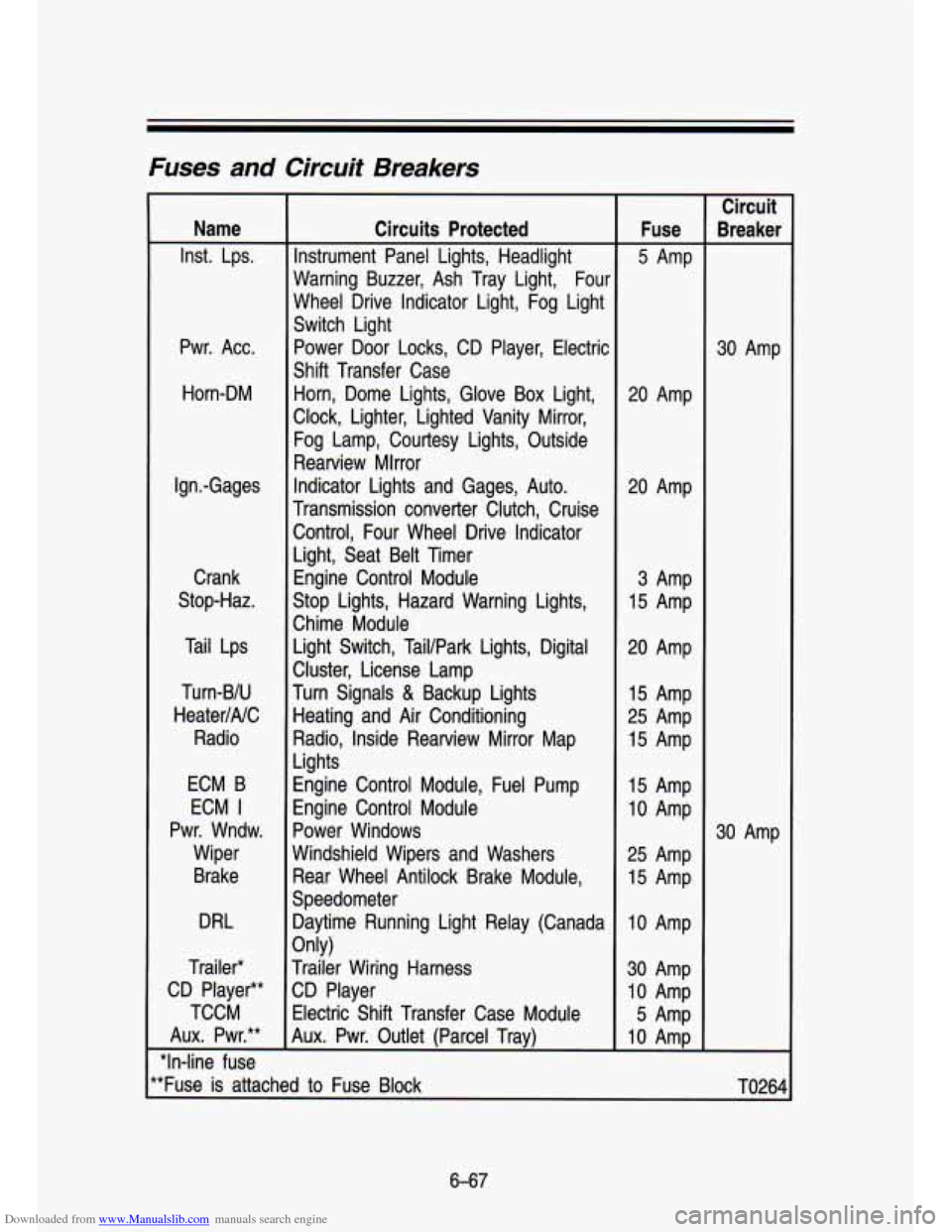
Downloaded from www.Manualslib.com manuals search engine Fuses and Circuit Breakers
Name
Inst. Lps.
Pwr. Acc. Horn-DM
Ign.-Gages Crank
Stop-Haz.
Tail Lps
Turn-BIU
HeaterINC Radio
ECM B
ECM
I
Pwr. Wndw. Wiper
Brake
DRL
Trailer*
CD Player**
TCCM
Aux. Pwr.**
"In-line fuse Circuits Protected
Instrument Panel Lights, Headlight
Warning Buzzer, Ash Tray Light, Four
Wheel Drive Indicator Light, Fog Light
Switch Light Power Door Locks, CD Player, Electric
Shift Transfer Case Horn, Dome Lights, Glove Box Light,
Clock, Lighter, Lighted Vanity Mirror,
Fog Lamp, Courtesy Lights, Outside
Rearview Mlrror
Indicator Lights and Gages, Auto.
Transmission converter Clutch, Cruise Control, Four Wheel Drive Indicator
Light, Seat Belt Timer Engine Control Module
Stop Lights, Hazard Warning Lights,
Chime Module Light Switch, Tail/Park Lights, Digital
Cluster, License Lamp
Turn Signals
& Backup Lights
Heating and Air Conditioning
Radio, Inside Rearview Mirror Map
Lights
Engine Control Module, Fuel Pump
Engine Control Module
Power Windows
Windshield Wipers and Washers Rear Wheel Antilock Brake Module,
Speedometer Daytime Running Light Relay (Canada
Trailer Wiring Harness
CD Player
Electric Shift Transfer Case Module
Aux. Pwr. Outlet (Parcel Trav)
Only) Fuse
5 Amp
20 Amp
20 Amp
3 Amp
15 Amp
20 Amp 15 Amp
25 Amp
15 Amp
15 Amp
10 Amp
25 Amp
15 Amp
10 Amp
30 Amp
10 Amp
5 Amp
10 AmD Circuit
kea ker
30 Amp
30 Amp
'*Fuse is attached to Fuse Block
TO264
6-67
Page 348 of 356
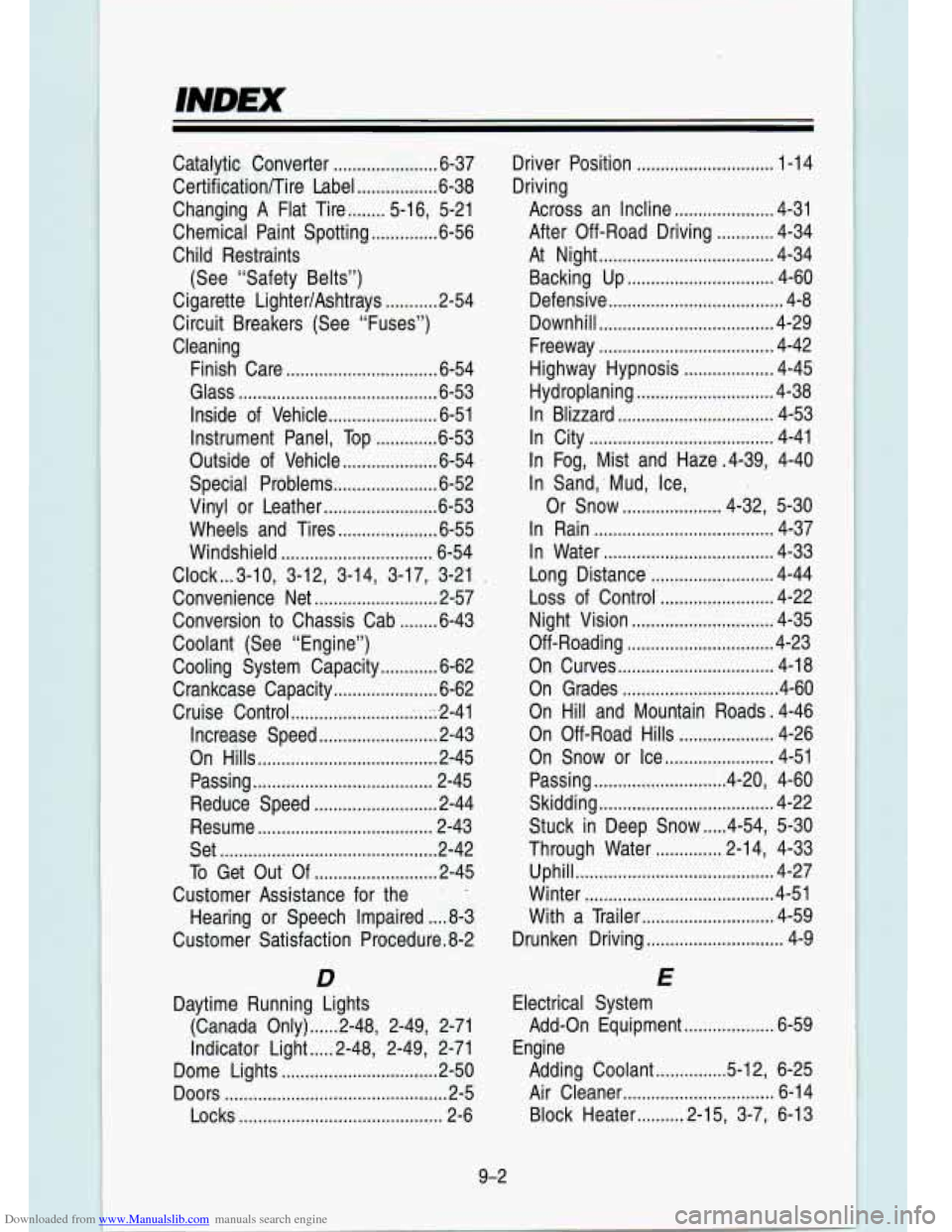
Downloaded from www.Manualslib.com manuals search engine INDEX
Catalytic Converter ......... ...... ..._. 6-37
CertificationlTire Label
................. 6-38
Changing A Flat Tire
........ 5-16, 5-21
Chemical Paint Spotting
.............. 6-56
Child Restraints
Cigarette LighterlAshtrays
........... 2-54
Circuit Breakers (See “Fuses”)
Cleaning (See “Safety
Belts”)
Finish Care
................................ 6-54
Glass
.......................................... 6-53
Inside of Vehicle
....................... 6-51
Instrument Panel, Top
............. 6-53
Outside
of Vehicle .................... 6-54
Special Problems
...................... 6-52
Vinyl or Leather
................-...... 6-53
Wheels and Tires
..................... 6-55
Windshield
................................ 6-54
Convenience Net
.......................... 2-57
Conversion
to Chassis Cab ........ 6-43
Coolant (See “Engine”)
Cooling System Capacity
............ 6-62
Crankcase Capacity
...................... 6-62
Cruise Control
................................ 2-41
Increase Speed
......................... 2-43
On Hills
...................................... 2-45
Passing
...................................... 2-45
Reduce Speed
......................... -2-44
Resume
..................................... 2-43
Set
.............................................. 2-42
To Get Out Of .......................... 2-45
Clock
... 3-10, 3-12,
3-14, 3-17, 3-21
Customer Assistance for the Hearing or Speech Impaired
.... 8-3
Customer Satisfaction Procedure.8-2
D
(Canada Only) ...... 2-48, 2-49, 2-71
Indicator Light
..... 2-48, 2-49, 2-71
Dome Lights
................................. 2-50
Doors
............................................... 2-5
Daytime Running Lights
Locks
........................................... 2-6 9-2 Driver Position
............................. 1-14
Driving Across an Incline
..................... 4-31
After Off-Road Driving
............ 4-34
At Night
..................................... 4-34
Backing Up
............................... 4-60
Defensive
..................................... 4-8
Downhill
..................................... 4-29
Freeway
..................................... 4-42
Highway Hypnosis
................... 4-45
Hydroplaning
............................. 4-38
In Blizzard
................................. 4-53
In City
....................................... 4-41
In Fog, Mist and Haze .4-39, 4-40
In Sand,
. Mud, Ice,
Or Snow
..................... 4-32, 5-30
In Rain
...................................... 4-37
In Water .................................... 4-33
Long Distance
.......................... 4-44
Loss of Control
........................ 4-22
Night Vision
.............................. 4-35
Off-Roading
............................... 4-23
On Curves
................................. 4-18
On Grades
................................. 4-60
On Hill and Mountain Roads
. 4-46
On Off-Road Hills
.................... 4-26
On Snow or Ice
....................... 4-51
Passing
............................ 4-20, 4-60
Skidding
..................................... 4-22
Stuck in Deep Snow
..... 4-54, 5-30
Through Water
.............. 2-14, 4-33
Uphill
.......................................... 4-27
Winter
........................................ 4-51
With a Trailer
............................ 4-59
Drunken Driving
............................. 4-9
E
Electrical System
Engine Add-on
Equipment
................... 6-59
Adding Coolant
............... 5-1 2, 6-25
Air Cleaner
................................ 6-14
Block Heater
.......... 2-15, 3-7, 6-13